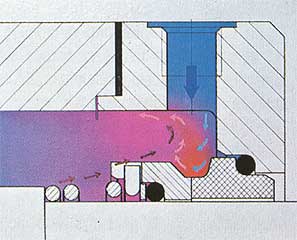| Frictional heat transfer | ||
Those parts of a mechanical seal's total power consumption attributable to power consumption and to turbulence losses must be dissipated completely in the form of heat. In mechanical seals with pumping screw, that part of the pumping screw's power consumption not transformed into compressive and fluidic energy is also present as heat. In the case of single mechanical seals the heat resulting from face friction (friction types) between the seal face and stationary seat is transferred almost totally to the process medium. A minimal remainder is dissipated via the adjoining components or directly into the atmosphere. In the case of single-acting mechanical seals with fluid quench and in the case of double mechanical seals with or without a pumping screw, the heat to be removed is transferred to both the process medium and the quench or buffer fluid. If possible the rise in temperature of the heat-absorbing fluids should not exceed 10 °C. If the temperature of the heat-dissipating fluid(s) lies close to its/their boiling point and/or if it is not possible to intensify the circulation sufficiently, concentration of heat at the sliding faces can be prevented by taking supplementary measures (flushing, cooling housing, stationary seat cooling, thermal decoupling, enlargement of radiating surfaces).
|
 Development of heat and heat flow in the stuffing box |
|